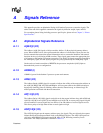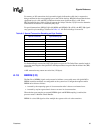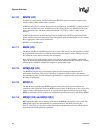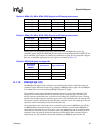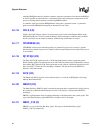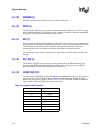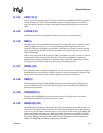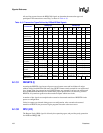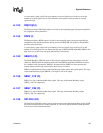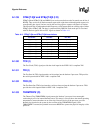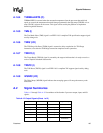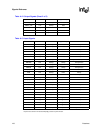
Datasheet 99
Signals Reference
A.1.33 FCL# (I/O)
The Flush Cache Line (FCL#) signal is driven to the bus on the second clock of the Request Phase
on the A[6]# pin. FCL# is asserted to indicate that the memory transaction is initiated by the global
Flush Cache (FC) instruction.
A.1.34 FERR# (O)
The FERR# signal may be asserted to indicate a processor detected error when IERR mode is
enabled. If IERR mode is disabled, the FERR# signal will not be asserted in the Itanium 2
processor system environment.
A.1.35 GSEQ# (I)
Assertion of the Guaranteed Sequentiality (GSEQ#) signal indicates that the platform guarantees
completion of the transaction without a retry while maintaining sequentiality.
A.1.36 HIT# (I/O) and HITM# (I/O)
The Snoop Hit (HIT#) and Hit Modified (HITM#) signals convey transaction snoop operation
results. Any bus agent can assert both HIT# and HITM# together to indicate that it requires a snoop
stall. The stall can be continued by reasserting HIT# and HITM# together.
A.1.37 ID[9:0]# (I)
The Transaction ID (ID[9:0]#) signals are driven by the deferring agent. The signals in the two
clocks are referenced IDa[9:0]# and IDb[9:0]#. During both clocks, ID[9:0]# signals are protected
by the IP0# parity signal for the first clock, and by the IP[1]# parity signal on the second clock.
IDa[9:0]# returns the ID of the deferred transaction which was sent on Ab[25:16]# (DID[9:0]#).
A.1.38 IDS# (I)
The ID Strobe (IDS#) signal is asserted to indicate the validity of ID[9:0]# in that clock and the
validity of DHIT# and IP[1:0]# in the next clock.
Table A-8. Extended Function Signals
Extended Function
Signal
Signal Name Alias Function
EXF[4]# Reserved Reserved
EXF[3]# SPLCK#/FCL# Split Lock / Flush Cache Line
EXF[2]# OWN#/CCL# Memory Update Not Needed / Cache Cleanse
EXF[1]# DEN# Defer Enable
EXF[0]# DPS# Deferred Phase Supported



